Our Motivation
Marginalized communities in the rural areas of the Central Valley are often unconnected to public water systems and have to rely on shallow domestic wells for their drinking water and other water needs. Over the past few decades, these domestic wells have been affected by widespread nitrate contamination above safe levels (known as maximum contaminant levels, or MCLs, which are set by the EPA), raising environmental justice concerns. Much of the nitrate in groundwater originates from industrial agricultural practices that rely on heavy use of synthetic nitrogen fertilizers and concentrated animal feeding operations (CAFOs) and their associated animal waste lagoons.
In 2006, the Central Valley Water Board initiated the Central Valley - Salinity Alternatives for Long-term Sustainability (CV-SALTS) program to seek and implement solutions to the widespread nitrate and salt contamination in shallow groundwater and wells. The program was conceived as a cooperative effort among (1) regulators (i.e., the State Water Resources Control Board (State Water Board), the Central Valley Regional Water Quality Control Board (Central Valley Water Board), and the US Bureau of Reclamation), (2) permittees from agriculture, dairy, food processing, municipal wastewater treatment, and oil and gas industries, and (3) environmental water quality and environmental justice organizations - emphasizing diverse representation and local and timely solutions. However, there has not been a comprehensive assessment of whether the CV-SALTS program lives up to the goals originally envisioned, and how the needs of the most vulnerable environmental justice communities are being served in the process. While the State of California recognized in 2012 that “every human being has the right to safe, clean, affordable, and accessible water” (Human Right to Water), over a million Californians are not being afforded this right as of today.
Our study has two main goals: We are evaluating how well the CV-SALTS process does in meeting its own goals to reduce nitrate in groundwater promptly, and how well environmental justice concerns are being addressed by the process. In addition, we seek to learn from communities in the CV-SALTS high-priority areas how the CV-SALTS process, specifically programs for additional well testing and bottled water delivery, has worked in practice. We are doing this work in collaboration with the California Rural Legal Assistance (CRLA), a non-profit organization dedicated to fighting for justice alongside the most exploited communities of our society. Our collaboration also (1) provides resources on nitrate contamination in the Central Valley, its impact on drinking water, and on well testing under the CV-SALTS process, (2) works to empower communities to learn about their rights and steps they can take - whether that be about how to get their domestic well tested, how to obtain safe bottled water, or how they can voice their concerns and join the solution process, (3) seeks to drive policy change to incorporate environmental justice considerations into the process, through, for example, public comments.
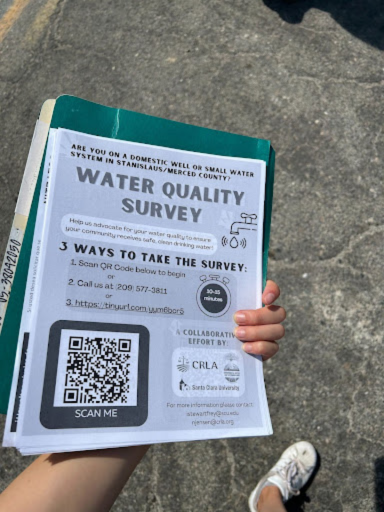
Flyer to invite residents to take the project’s water quality survey.
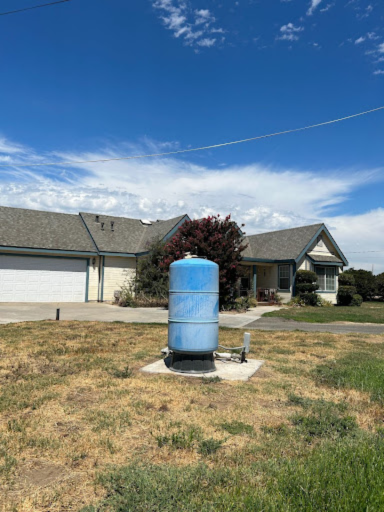
Domestic well in an area where nitrate levels are thought to be high within the Modesto Priority 1 basin.
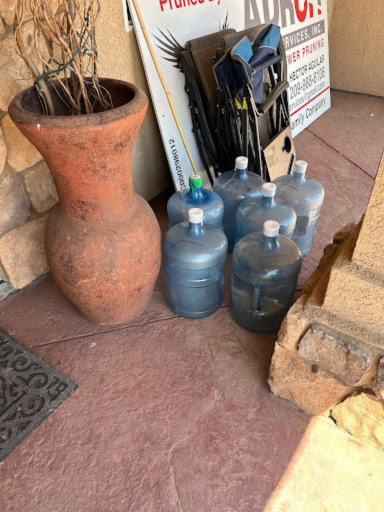
Empty 5-gallon water bottles used to distribute safe water to residents testing above the maximum contaminant levels for nitrates at 10 mg/l.
Our Approach
We developed a survey asking questions about water access, well water quality, experiences with well testing under CV-SALTS, and the CV-SALTS outreach efforts and distributed it in communities not connected to public water systems in the Modesto and Turlock Priority 1 Management Zones (which are located in the Stanislaus and Merced counties). The survey contained 23 questions and could be taken online in English and Spanish between May and November 2023. Distribution of the survey was through local schools, community gathering places (i.e. local flea markets), and door-to-door outreach.
In addition, we conducted a comparative analysis of Early Action Plan Reports for all Priority 1 Basins under CV-SALTS (Modesto, Turlock, Kings, Chowchilla, Kaweah, Tule). The progress of each projected CV-SALTS goal from 2021 - 2023 with its stipulated timeline and the projected long-term sustainable goals, if applicable, among Priority 1 Basin based on their progress, longevity, and effectiveness are compared among all Management Zones. Geospatial analysis included mapping the progress of priority basins on CV-SALTS management plans throughout the Central Valley, and mapping how Priority 1 and 2 basins, where nitrate contamination is high, intersected with disadvantaged communities.
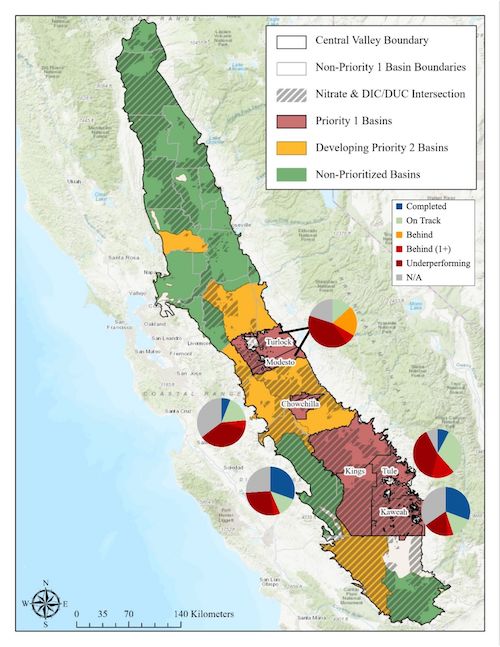
Our Results
We were able to survey over 100 residents in the Modesto and Turlock priority basins that are dependent on domestic wells. Their responses demonstrated that concerns over water quality, especially nitrate, are rampant. Frequently residents have to contend not only with contaminated water but also with having access to sufficient water. Even though outreach is a main charge of the CV-SALTS process, over 70% of the respondents to our survey had not heard of CV-SALTS. These residents who have never heard of the CV-SALTS program do not have input in the solutions and continue to be exposed to high water contamination. We are planning to expand this work to other priority 1 and 2 basins.
Our work has documented that the CV-SALTS program is underperforming in all four main categories of its projected timeline, including quarterly general meetings, updating mailing lists, general community outreach, and follow-up outreach. When analyzing the Early Action Plans, we found that the bottled water delivery program is not always adequate to cover water needs, especially with services occurring only every two weeks with 3-5 gallons of water typically distributed - a very small amount of water, especially for households with larger families. This is despite households with families and the average consumption of water, in gallons, across California range in the 40’s. We also found source reduction and comprehensive monitoring are not prioritized in the goals and the CV-SALTS is lagging behind its own generous timelines, exposing vulnerable communities to unsafe drinking water for longer periods. Survey results have shown widespread concern about water quality in disadvantaged communities (DACs) on wells or small water systems, yet the CV-SALTS process has not sufficiently served the water justice needs of DACs. When surveying community members we found residents remain fearful and resistant to questioning water quality/contributing to surveys, especially in instances where employers (i.e. dairy operations) also act as landlords. Many community members also remain unaware of the CV-SALTS process, opportunities for well testing, and bottled water deliveries even after the management collaboratives have performed initial outreach. We highly recommend the program collaborates with outside environmental justice organizations to bridge methods and resources to achieve their shared goal and residents should be informed to look for other contaminants besides nitrate including (but not limited to) 1, 2, 3 TCP, DBCP, uranium, and arsenic.
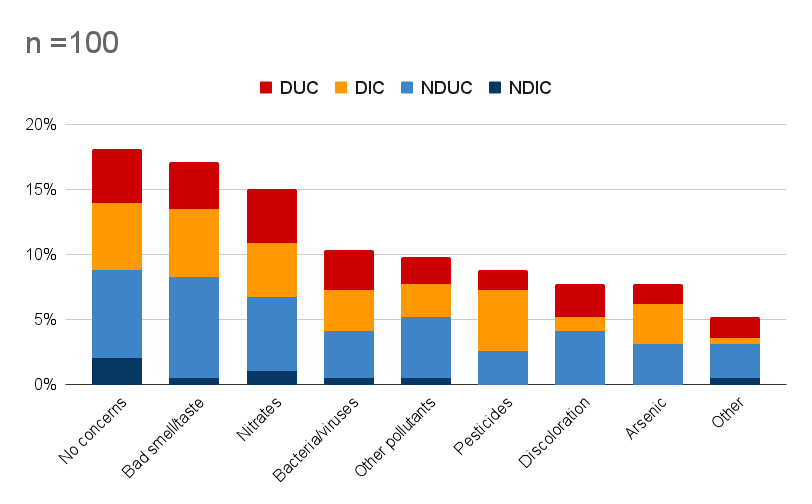
Over 80% of respondents reported water quality concerns with nitrates reported as the highest chemical concern, and concerns most widespread in disadvantaged unincorporated and disadvantaged incorporated areas (orange and red). Pesticides, arsenic, bacteria/viruses, and other pollutants were also frequently listed as contaminants of concern.
Figure by Samantha Lei, Iris Stewart-Frey, Jake Dialesandro, and Nick Jensen.
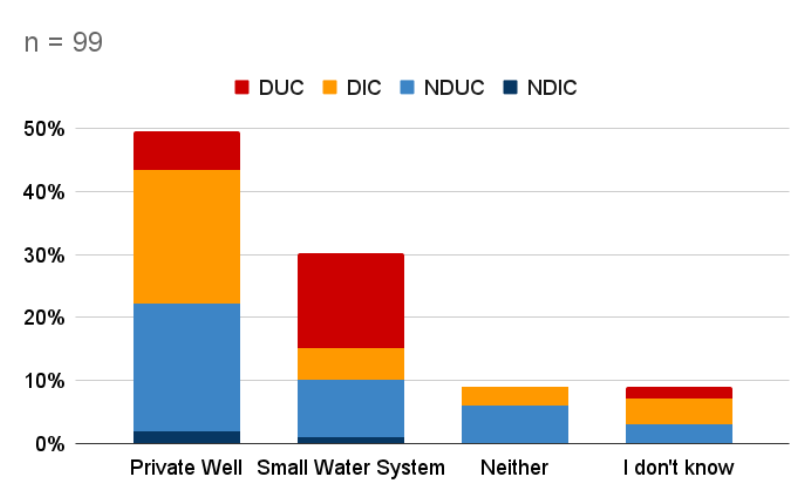
50% of respondents reported dependence on private wells for drinking water and 80% are dependent on both private and/or small water systems for drinking water. With such a large portion dependent on domestic wells that tap shallow groundwater, contaminants precipitate significant health concerns for vulnerable populations.
Figure by Samantha Lei, Iris Stewart-Frey, Jake Dialesandro, and Nick Jensen.
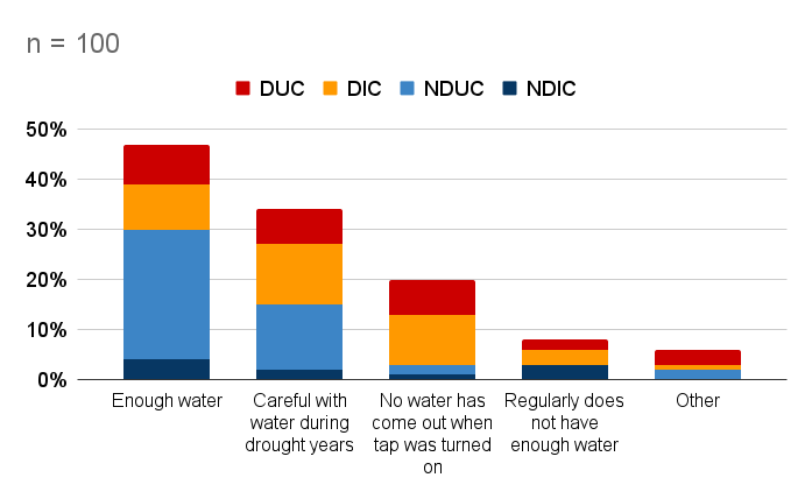
45% of respondents reported at least having to be conservative with their water usage over the past five years, and 1 in 5 residents reported times of no water availability from turning on their tap.
Figure by Samantha Lei, Iris Stewart-Frey, Jake Dialesandro, and Nick Jensen.
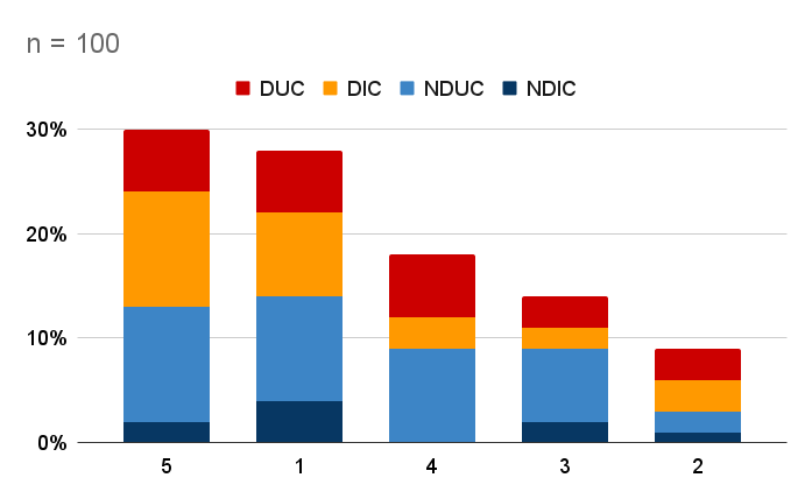
1 = not concerned, 2 = somewhat concerned, 3 = moderately concerned, 4 = concerned, 5 = highly concerned
Over 60% of survey respondents were at least moderately concerned to highly concerned about their water quality.
Figure created by Samantha Lei, Iris Stewart-Frey, Jake Dialesandro, and Nick Jensen.
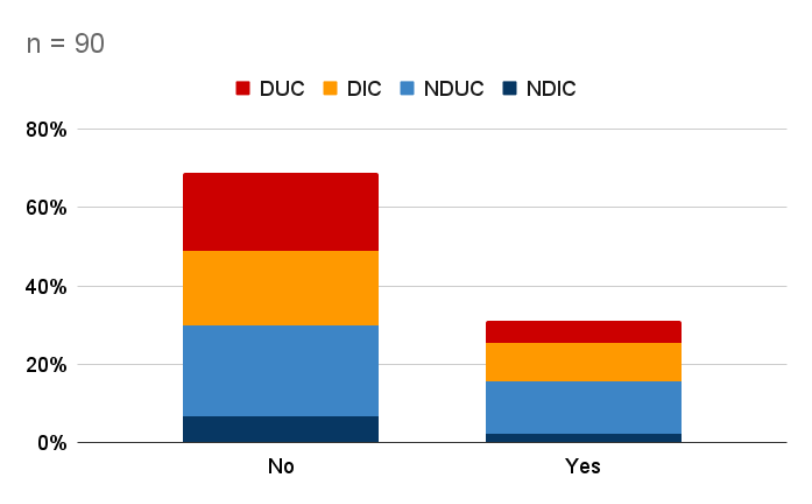
Over 70% of respondents were unaware of VWC’s presence and safe water programs even in Priority 1 basins where CV-SALTS outreach is a priority. Communities unaware of the CV-SALTS process do not receive support and their voice is excluded from the active solution process while they continue to be exposed to contaminated water.
Figure created by: Samantha Lei, Iris Stewart-Frey, Jake Dialesandro, and Nick Jensen.
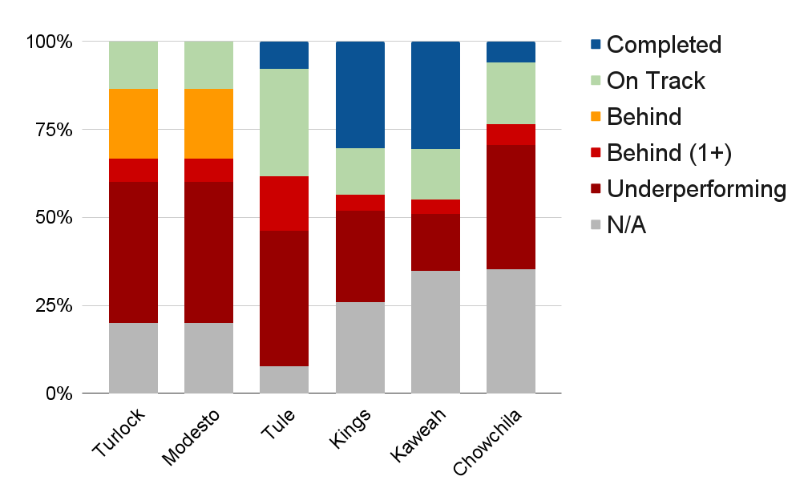
Over 50% of milestones identified in Priority 1 CV-SALTS basins had not been met as of December 2023. In addition, our study found that transparency about progress on goals is limited – impeding efforts by environmental justice communities and environmental justice organizations to push for more time-effective change and realize access to safe water for all Central Valley residents.
Figure created by Samantha Lei, Iris Stewart-Frey, Jake Dialesandro, and Nick Jensen.